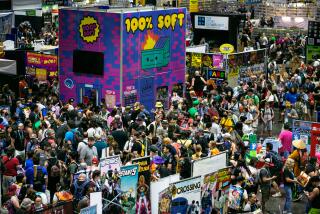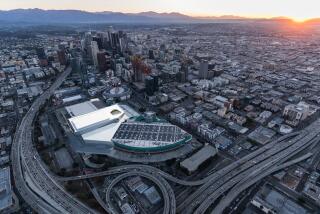Trade Shows Boom Despite Economy Lag : Exhibitions: Promoters and visitors alike say the gatherings represent a highly effective, legitimate and viable way of doing business.
- Share via
SAN DIEGO — As 200 exhibitors and 3,000 registered visitors gather in San Diego this week for the International Exhibitors Assn. convention--or the “Trade Show of Trade Shows”--the bywords have been economy and accountability.
Perhaps that explains the success of companies such as Exhibit Registry, a Huntington Beach firm that buys and sells used exhibits. Owner Stefane D’Avad bills his firm as the “Cal Worthington of trade shows” and says he has single-handedly created an “after market” for used exhibits by appealing to the budgetary concerns of corporate exhibitors.
“I sell a 20-foot-by-20-foot exhibit that costs $55,000 to build from scratch for $20,000,” said D’Avad, 49, a French Canadian, who founded his firm in 1987 after a career in merchandising design. “People used to dismantle and throw away their exhibits, but I save them the $2,000 to $3,000 it costs to dispose of them and pay them a few bucks in addition.”
Exhibit Registry has an inventory of 100 used exhibits but plans to expand that to 2,000. D’Avad said his target market is companies that see the need to display their wares or services at trade shows but can’t afford to pay from $40,000 to $180,000, which is what custom-built booths can cost.
Industry research suggests that the booths are highly cost-effective. Trade Show Bureau, a Denver-based industry-information clearinghouse, says the average cost of sales developed from leads generated at trade shows is $142 a deal, contrasted with a $259 average cost of each sale developed through direct calls by outside staff.
That sort of effectiveness is why trade shows and conventions are a $50-billion industry, humming along at a 7% annual growth rate in exhibitors and attendance, despite the economic downturn of the past two years that has put a crimp in many companies’ marketing and travel budgets, said Jane Lorimer, president of Trade Show Bureau. The industry has always prided itself as being recession-resistant.
About 35 million Americans attend at least one trade show a year, up 72% from 10 years ago. An estimated 8,000 U.S. companies exhibit each year at trade shows and conventions, up from 4,500 companies a decade ago, Lorimer said. The industry’s gathering this week at the San Diego Convention Center drew a record number of exhibitors and visitors.
Trade shows are valuable because they serve to generate solid sales leads from serious customers. In fact, leads developed at trade shows take an average of less than one additional sales call to close, contrasted with four sales visits developed through cold calling, Lorimer said.
Still, Lorimer said companies are much more concerned these days that their money be well spent. And they go to greater lengths than ever to track sales leads developed at conventions to measure the number of deals closed.
“We used to be viewed as a ‘booze, broads and bananas’ business with models who looked good showing products but who couldn’t answer any questions,” Lorimer said. “In the old days, it was hats and horns and party time. Now it’s a business.”
“The biggest word is accountability, and trade shows are one of the most measurable marketing tools there is. You can account for every direct cost and track every direct sale,” Lorimer explained.
As is readily apparent at this week’s convention in San Diego, the exhibition industry has become more and more sophisticated as businesses recognize how critical trade shows can be to an overall marketing strategy.
Although some companies, such as D’Avad’s clients, are economizing, others are incorporating $180,000 “video walls” into their booths, buying Plexiglas and aluminum superstructures, all made with intricate, jigsaw puzzle-like construction that must stand up to significant wear and tear.
Tom Grossman, manager of exhibitions and special events at Unisys, the Blue Bell, Pa.--based computer manufacturer, said his company will exhibit at 80 national trade shows this year, using six “families of exhibit properties.”
“The exhibit industry is not recession-proof, but resilient,” said Grossman, who is also senior vice chairman of International Exhibitors Assn. “It’s because annual conferences are enjoying a resurgence, and the reason is that trade shows more and more represent a legitimate and viable way of doing business.”
O.C.’s Trading Places Attendance at trade shows and conventions in Orange County has increased 27% in the past five years, while the number of events has grown by 22%
Convention Spending Revenues from all types of convention-related spending have doubled since 1986, although the past two years have fallen short of 1988’s $1.3-billion peak.
Revenue Breakdown Local transportation: 6% Other*: 15% Hotel: 47% Non-hotel restaurants: 13% Hotel restaurants: 13% Retai stores: 6% *Nightclubs, admission, hospitality suites, etc. Researched by DALLAS M. JACKSON / Los Angeles Times
More to Read
Inside the business of entertainment
The Wide Shot brings you news, analysis and insights on everything from streaming wars to production — and what it all means for the future.
You may occasionally receive promotional content from the Los Angeles Times.










